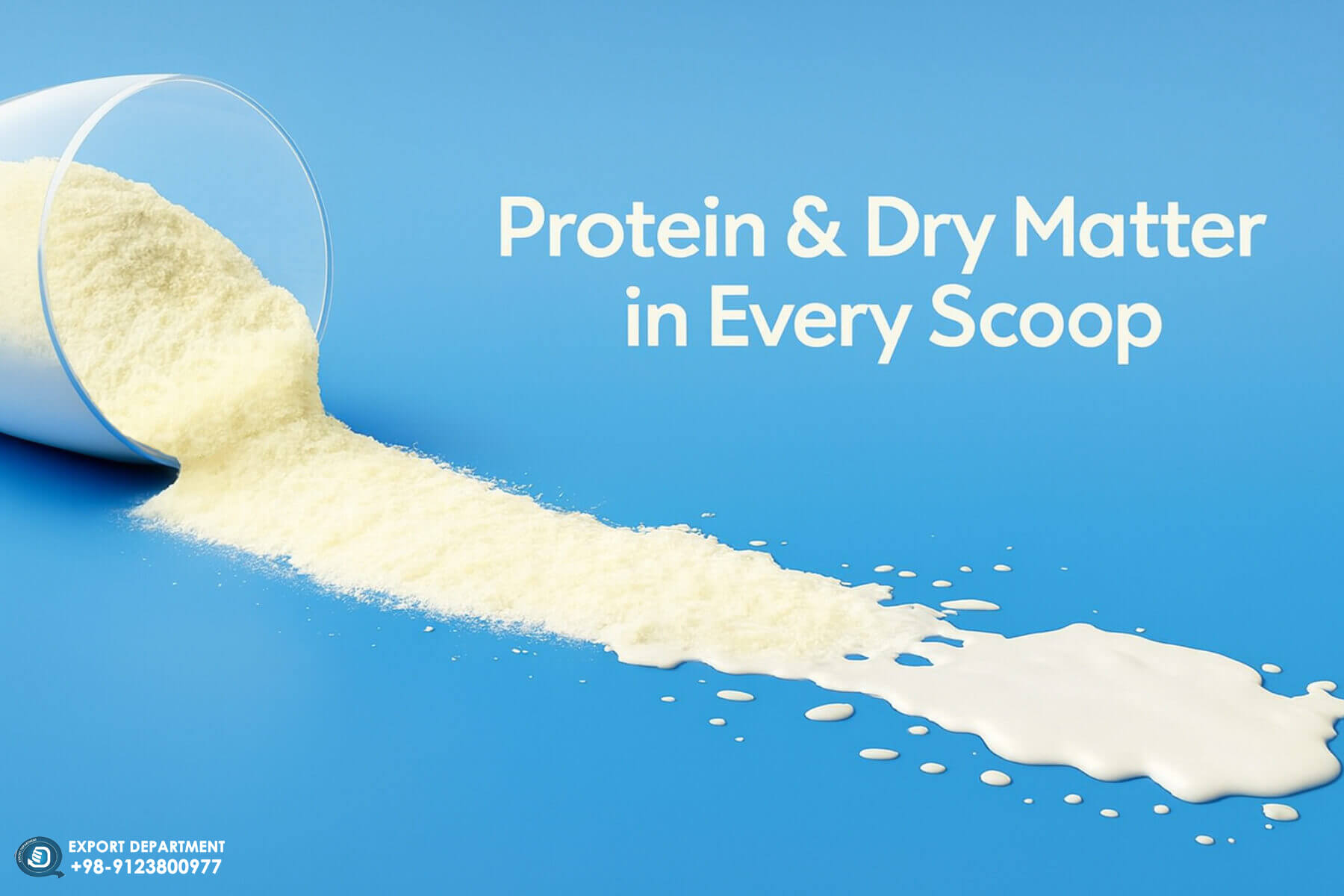Skim Milk Powder in Baking: Better Texture, More Intense Flavor
A professional overview of skim milk powder in baking applications, focusing on its role in improving structure, fermentation, texture, and flavor consistency.
A Functional Ingredient for Modern Baking
In industrial and professional baking, product quality often depends on precise ingredient selection. Beyond the basic staples of flour, sugar, butter, and eggs, certain functional ingredients can significantly improve consistency, shelf life, and sensory characteristics. Skim milk powder (nonfat dry milk) is one of these ingredients.
Milk powder is available in various forms, including whole milk powder (which contains fat), skimmed milk powder (which is nonfat), and non-dairy alternatives like almond or coconut milk powder. A key characteristic that makes it invaluable in baking is its neutral flavor profile. It subtly enhances the richness and inherent sweetness of a recipe without introducing any dominant or overpowering notes.
Produced by removing water from fresh milk, skim milk powder delivers concentrated proteins, lactose, and minerals in a stable, easy-to-handle form. Its application in bakery products is well established due to its ability to improve dough handling, support fermentation, optimize texture, and enhance flavor.
Kelly Mencin, pastry chef and partner at Radio Bakery, notes that straight out of the bag, milk powder already lends a creamy, milky flavor profile. Chef Christina Tosi, author of "Momofuku Milk Bar", goes further, stating she cannot think of a dessert that milk powder would not improve. Tosi explains that milk powder possesses an "amazing way of adding a terrific baseline flavor". While the powder itself might not taste like anything extraordinary when sampled directly from the container, Tosi considers it a "secret weapon ingredient" that works magic when incorporated into a recipe. For general use, Tosi advises home cooks to simply experiment by adding a tablespoon of milk powder to the dry ingredients in any baking project, confirming that it "just makes things taste better".
Key Functional Benefits of Skim Milk Powder
Moisture Control and Dough Stability
While whole milk powder is often chosen for maximum richness, skimmed milk powder (nonfat dry milk) holds a sterling reputation among bakers, especially for its unique ability to manage moisture and refine structure.
One of the greatest challenges in baking is moisture management; adding liquid milk often introduces too much water to batters and doughs, potentially compromising the final texture. Skim milk powder solves this dilemma by supplying essential proteins and sugars in a highly concentrated, dry form. This allows the baker to retain the benefits of milk—structure and flavor—while maintaining unparalleled control over the liquid content of the recipe.
Protein Contribution
Milk proteins strengthen dough structure, improve gas retention, and contribute to crust formation. This is particularly important in bread and enriched dough applications, where a stable gluten network and proper fermentation are critical.
For cookies, the impact is immediately noticeable: Mencin confirms that the added protein content from the milk powder is responsible for giving the cookies a desirable chewy quality and helping them form a great crust. Epi contributor Ramin Ganeshram agrees, asserting that "nothing is better than milk powder" for giving cookies a chewy texture and a slight crust, making it an ideal addition for classic chocolate chip cookies. Tosi highlights that milk powder can specifically make cookies chewier.
Lighter Texture in Delicate Products
In applications such as flatbreads and fine cakes, skim milk powder provides tenderness and volume without adding extra fat. However, since it also increases solids, overuse without adjusting hydration or adding plasticizing agents (like fat or emulsifiers) may cause dryness or toughness in the crumb.
Flavor Development
Skim milk powder contributes subtle dairy notes and enhances the natural sweetness of bakery products. In chocolate applications, it balances bitterness and creates a more consistent flavor profile. During baking, its lactose content also promotes Maillard browning, leading to an appealing golden crust. Caution: at high oven temperatures or with prolonged baking, excessive lactose can increase the risk of over-browning or scorching if not carefully controlled.

Industrial Applications of Skim Milk Powder in Baking
Bread and Enriched Doughs
The addition of 4–5% skim milk powder relative to flour weight supports yeast fermentation, increases loaf volume, and improves crumb softness. The optimal dosage depends heavily on the specific formula, including liquid content, sugar levels, fat amount, and the presence of other enzymes or ingredients. This is especially effective in white bread, sandwich bread, and rolls.
Cakes and Fine Bakery Products
- Sponge and Pound Cakes: Provides a finer crumb structure and increased stability.
- Chocolate Cakes: Balances cocoa bitterness and deepens flavor.
- Layer Cakes: Contributes to even structure and consistent rise.
Cookies and Biscuits
Skim milk powder increases chewiness and improves crust formation. Even small additions (1–2 tablespoons per batch) can significantly enhance texture.
Flatbreads
In paratha, roti, and other flatbreads, small amounts of skim milk powder improve tenderness and handling properties without adding unwanted heaviness.
Frozen Desserts
In ice cream production, skim milk powder is widely used to increase milk solids, improve body, and create a smoother, denser texture.
Fillings and Creams
When blended with sugar, skim milk powder adds stability and creaminess to buttercream, ganache, and custards.
Usage Guidelines
- Dosage in Bread: 4–5% of flour weight. (Note: the exact percentage should be adjusted depending on the overall formula, including hydration level, sugar, fat, and enzyme content.)
- Cakes: 2–4 tablespoons per cup of flour.
- Milk Substitution: 1 cup liquid milk ≈ 1 cup water + 3 tablespoons skim milk powder (This is an approximate home-scale guideline and may differ from the solids or fat content of liquid milk in industrial use).
- Mixing Technique: Always sift with dry ingredients to prevent clumping. For better solubility in industrial applications, instant or agglomerated skim milk powder is recommended.
Application Table: Skim Milk Powder in Bakery and Dessert Production
|
Application |
Recommended Addition |
Primary Function |
|
White bread / rolls |
4–5% of flour weight |
Supports fermentation, higher loaf volume |
|
Sponge / pound cakes |
2–3 tbsp per cup flour |
Fine crumb, structural stability |
|
Chocolate cakes |
1–2 tbsp with flour & cocoa |
Enhances cocoa flavor, reduces bitterness |
|
Cookies / biscuits |
1–2 tbsp per batch |
Chewier texture, improved crust |
|
Flatbreads |
2 tsp mixed with flour |
Tender, soft texture |
|
Ice cream & frozen desserts |
3–4 tbsp per batch |
Increased milk solids, creamier body |
|
Fillings / creams |
Blend with powdered sugar |
Improved stability, smoother texture |
Troubleshooting and Quality Considerations
- Dense Product: Caused by excessive addition of milk powder or insufficient hydration. Adjust balance of liquids and solids.
- Dry Texture: Milk powder is hygroscopic; increase liquid content if dryness occurs.
- Lumps in Batter: Prevent by sifting with dry ingredients or dissolving in liquid before use. For commercial applications requiring optimal dispersion, using instant or agglomerated skim milk powder is recommended to enhance solubility and minimize lumping.
Frequently Asked Questions
1. Can I use milk powder instead of fresh milk in my cake recipes?
Yes, you can substitute milk powder for liquid milk. To do this, you need to rehydrate the milk powder with water. The standard ratio for substitution is to combine "1 cup of water with 3 tablespoons of milk powder" to replace 1 cup of liquid milk.
2. Does milk powder significantly alter the flavor of cakes or baked goods?
Milk powder possesses a neutral flavor and typically enhances the natural sweetness and richness of cakes without introducing a dominant or distinct flavor of its own. It imparts a subtle yet profound richness and depth, intensifying the overall taste. However, in extremely delicate or neutrally flavored products (such as angel food cake), the subtle dairy notes or “milkiness” of SMP may be perceptible, and usage should be tested and balanced.
3. Is milk powder suitable for vegan or dairy-free baking?
Traditional dairy milk powder is not suitable for vegan baking. However, non-dairy alternatives, such as "coconut milk powder or almond milk powder", are available. These non-dairy powders can be used in vegan recipes and mimic the beneficial properties of traditional milk powder.
4. What should I do if my cake turns out too dense after adding milk powder?
If your cake is too dense, the cause is usually either the use of excessive milk powder or insufficient liquid in the batter. Since milk powder absorbs moisture, using too much without adequate liquid can dry out the batter. To solve this, you should use the correct ratio (typically 2 to 4 tablespoons per cup of flour) and, if necessary, incorporate additional liquid to balance the dryness.
Storage and Stability Note: Skim milk powder is hygroscopic and readily absorbs moisture. It may also be prone to caking and, over time, oxidation of residual lipids. To maintain powder quality, it must be stored in sealed packaging under cool temperatures and low humidity conditions.
Conclusion: A Reliable Functional Ingredient
Skim milk powder is a well-established functional ingredient in the baking and confectionery industries. Its ability to improve fermentation, enhance structure, manage moisture, and contribute to flavor development makes it indispensable for consistent product quality.
From breads and cakes to cookies, flatbreads, and frozen desserts, its versatility is unmatched. By using the correct dosage and handling methods, bakers and manufacturers can achieve reliable improvements in both texture and flavor.
For consistent industrial results, high-quality options such as Chaltafarm Instant Skim Milk Powder provide the functionality required to meet today’s demanding bakery standards.
Ref:
What Is Powdered Milk—and How to Use It in Your Cooking
Milk Powder Is the Key to Better Cookies, Brownies, and Cakes | Epicurious
The Effect of Heat Treatment of Skim Milk upon the Baking Quality of the Evaporated and Dried Products


.jpg)
.jpg)


.jpg)